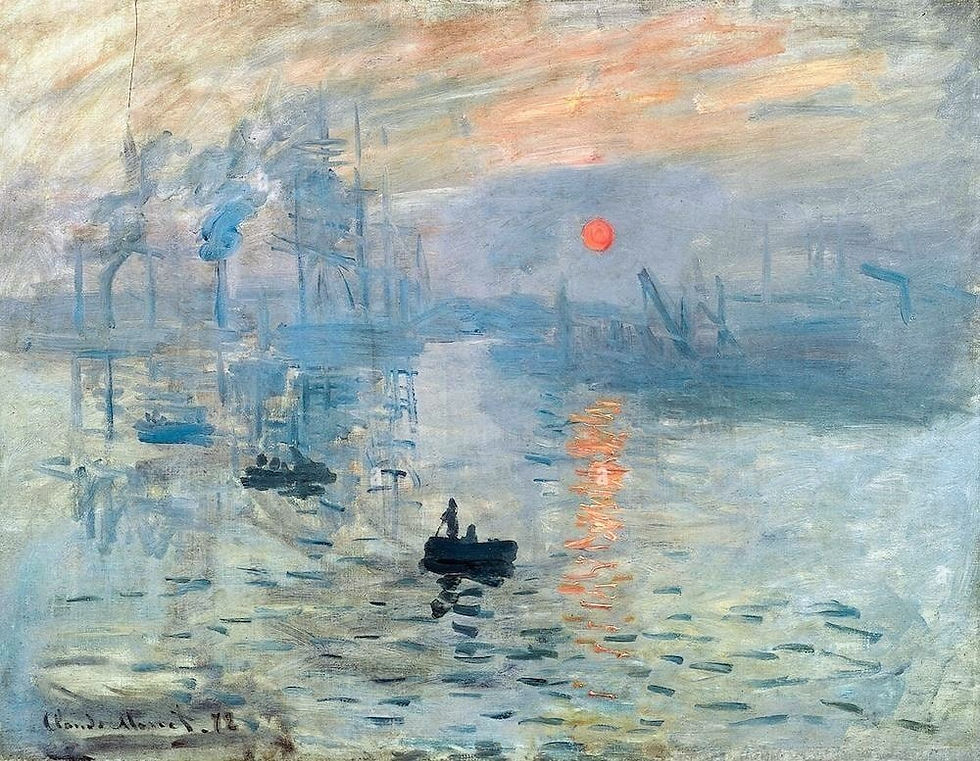A Study of Light and Contrast: Turner’s Fishermen at Sea and Monet’s Impression, Sunrise
- Emily Cho '27

- 4 days ago
- 3 min read
By Emily Cho 27' • Nov 11, 2025
When Claude Monet painted Impression, Sunrise in 1872, critics accused him of being careless—his brushstrokes too loose, his forms too vague. Yet that very painting gave birth to Impressionism, a movement that transformed how we see light and emotion on canvas. Nearly a century earlier, another artist had already captured the drama of light in a very different way: J.M.W. Turner, whose Fishermen at Sea (1796) marked the beginning of his rise as Britain’s Romantic master of atmosphere.
Though both paintings center on the play between light and darkness, they speak entirely different artistic languages. Turner’s moonlit sea and Monet’s glowing sunrise reveal two contrasting visions of how artists interpret nature—one rooted in realism and the Sublime, the other in fleeting perception and emotion.

The Language of Color
Monet’s Impression, Sunrise bathes the viewer in misty tones of pale blue, pink, and lavender. The scene feels half-awake, as if the world is just emerging from sleep. Against this muted palette, the blazing orange sun shatters the haze, drawing the eye to its reflection rippling across the water. It is not the harbor or the boats that hold the focus, but light itself—the pulse of morning suspended in paint.
Turner’s Fishermen at Sea could not be more different. His sea is a storm of darkness—deep black waves pierced by the cold, white moonlight. The emerald glimmer of water near the fishermen’s lantern creates a fragile circle of warmth amid the vast, menacing ocean. Where Monet paints tranquility, Turner paints awe. His use of contrast—light versus shadow, safety versus danger—captures the Romantic obsession with nature’s overwhelming power.
Realism and Imagination
For Monet and his fellow Impressionists, accuracy was secondary to emotion. The boats in Impression, Sunrise dissolve into mist; the water shimmers in hurried, broken strokes. What matters is not the precision of the lines but the sensation of light changing moment by moment. The canvas feels alive, vibrating with movement and immediacy.
Turner, on the other hand, pursued realism through Romantic ideals. In Fishermen at Sea, every wave crest and shadow is carefully rendered. The lantern’s reflection glows orange on the black water, and the moonlight grazes the birds’ wings in delicate precision. Even as the painting dramatizes nature’s Sublime vastness, Turner grounds it in tangible detail—the ripples, the glow, the fragile human presence at sea.
Brushwork and Emotion

Monet’s brushstrokes are quick and visible—thin, loose, and rhythmic. They seem to chase the sunlight across the water, never staying still. In contrast, Turner’s hand is controlled and deliberate. His waves and skies blend seamlessly, the motion subdued beneath smooth layers of oil. The two painters share a fascination with light, but their methods diverge: Monet captures its ephemerality; Turner, its power.
Two Visions, One Theme
Both paintings ultimately meditate on humanity’s relationship with nature. Monet’s dawn over Le Havre suggests renewal and calm—the quiet birth of a new day. Turner’s nocturnal sea evokes isolation and peril, the smallness of man against the vast, unrelenting sea. One glows with gentle optimism; the other trembles with reverence and fear.
Nearly eighty years apart, the two works mirror each other like reflections in water: Fishermen at Sea as a Romantic hymn to nature’s majesty, and Impression, Sunrise as a modern meditation on perception itself. Each reveals that light—whether from the sun or the moon—remains painting’s most powerful language.
Artwork Details
Title | Artist | Year | Medium | Location |
Impression, Sunrise | Claude Monet | 1872 | Oil on canvas | Musée Marmottan Monet, Paris |
Fishermen at Sea | J.M.W. Turner | 1796 | Oil on canvas | Tate Britain, London |




Comments